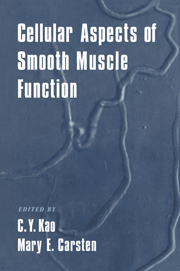Book contents
- Frontmatter
- Contents
- List of contributors
- Preface
- List of abbreviations
- 1 Morphology of smooth muscle
- 2 Calcium homeostasis in smooth muscles
- 3 Ionic channel functions in some visceral smooth myocytes
- 4 Muscarinic regulation of ion channels in smooth muscle
- 5 Mechanics of smooth muscle contraction
- 6 Regulation of smooth muscle contraction by myosin phosphorylation
- 7 Structure and function of the thin filament proteins of smooth muscle
- Index
7 - Structure and function of the thin filament proteins of smooth muscle
Published online by Cambridge University Press: 04 August 2010
- Frontmatter
- Contents
- List of contributors
- Preface
- List of abbreviations
- 1 Morphology of smooth muscle
- 2 Calcium homeostasis in smooth muscles
- 3 Ionic channel functions in some visceral smooth myocytes
- 4 Muscarinic regulation of ion channels in smooth muscle
- 5 Mechanics of smooth muscle contraction
- 6 Regulation of smooth muscle contraction by myosin phosphorylation
- 7 Structure and function of the thin filament proteins of smooth muscle
- Index
Summary
The goal of this chapter is to explore possible models by which caldesmon and calponin may alter the force-producing interaction between myosin and actin and how the inhibitory activity of caldesmon and calponin may be controlled. Contraction may be potentially regulated by altering the properties of either myosin or actin. In both cases, one or more of many possible transitions in the cycle of ATP hydrolysis by actomyosin may be affected, including (but not limited to) the binding of myosin to actin, the binding of ATP, Pi, and ADP to actomyosin, and cooperative transitions between the active and inactive forms of the actintropomyosin filament. A detailed account of these transitions is not possible here but may be found elsewhere (Chalovich 1992).
Evidence for actin filament-mediated regulation
Phosphorylation of the 20-kDa myosin light chain (MLC20) by the Ca2+ − and calmodulin-dependent myosin light chain kinase (MLCK) is generally thought to be the primary event initiating smooth muscle contraction (for reviews see Kamm and Stull 1985; Somlyo and Somlyo 1994; and Chapter 6 of this volume). In fact, there is evidence that MLC20 phosphorylation is sufficient to trigger smooth muscle contraction (Itoh et al. 1989). On the other hand, numerous physiological studies have shown that there is no fixed relationship between isometric force and MLC20 phosphorylation. During prolonged contraction MLC20 phosphorylation, crossbridge cycling rates, and intracellular Ca2+ decrease while force is fully maintained by the so-called latch state (Dillon et al. 1981; see also Kamm and Stull 1985 for a review).
Information
- Type
- Chapter
- Information
- Cellular Aspects of Smooth Muscle Function , pp. 253 - 288Publisher: Cambridge University PressPrint publication year: 1997
Accessibility standard: Unknown
Why this information is here
This section outlines the accessibility features of this content - including support for screen readers, full keyboard navigation and high-contrast display options. This may not be relevant for you.Accessibility Information
- 5
- Cited by
